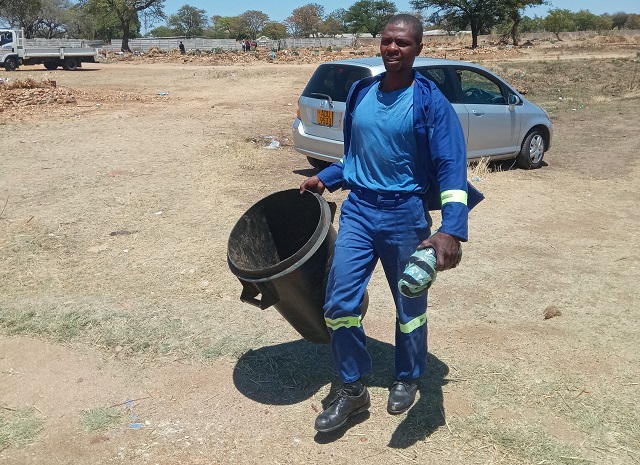Village health workers scale up fight against malnutrition

Charity Ruzvidzo
AS the country continues its efforts to curb malnutrition, village health workers remain the necessary asset in provision of primary health care in rural communities.
Mr Khumbulani Bhebhe (33) is a typical example of the many selfless men and women across the country’s rural areas who have dedicated most of their time to educate communities on malnutrition and encouraging healthy habits in people’s lives.
Mr Bhebhe, who has been a village health worker for seven years at Hamilton Farm in Lower Gweru, Midlands province, strives to create a society that does not harbour malnourished children.
The 2016 ZimVac report identified Gweru among the food insecure areas with high levels of malnutrition in the country induced by the El Nino weather phenomenon.
It is against this background that Mr Bhebhe is faced with the greatest challenge of ensuring villagers in his area are aware of the implications of malnutrition.
Malnutrition is a condition that results from either poor dietary intake or underlying disease. Often the two occur simultaneously, a poor nourished child is susceptible to disease and an ill child is more prone to malnutrition.
Mr Bhebhe rides his bicycle for more than 25 kilometres to reach communities that are affected by malnutrition.
He goes door to door, sometimes under the scorching sun, in the rain and areas with dangerous wildlife encouraging people to fight malnutrition.
“Being a health worker has enabled me to reach a large number of people and teach them about malnutrition. It is sad to note that children are losing their lives due to lack of education on the importance of a balanced diet,” said Mr Bhebhe.
He encourages villagers to use their farm produce to provide a balanced diet for their families.
“Some parents do not provide a balanced diet to their children because they assume they should buy expensive food to do so. However, this is not the case; food from their farms can be used to create a balanced diet,” said Mr Bhebhe.
Despite his passion to encourage the creation of a healthy society, he faces rejection at some homesteads.
“Being a male village health worker comes with many challenges especially when addressing women on exclusive breastfeeding. It requires me to graphically explain some procedures on recommended methods of breastfeeding. This has led some men to mock and scorn me for doing a female job,” said Mr Bhebhe.
The Ministry of Child and Health Care in collaboration with Save the Children, a non-governmental organisation that focuses on children’s welfare, have put in place measures to promote the end of malnutrition.
Save the Children Zimbabwe communications adviser, Ms Sophie Hamandishe, said their organisation has also stepped in by providing incentives to village health workers.
“We have emergency nutrition response programmes in areas such as Gweru, Bindura, Shamva, Guruve and Chegutu. complementary to Government efforts, we are also assisting village health workers with necessary material to use when identifying and monitoring malnourished children,” she said.
Ms Hamandishe said consumption of the four star diet is crucial in reducing malnutrition in rural areas.
“We have managed to educate village health workers about the four star diet that comprises animal sources foods, staples, legumes and vitamin A rich fruits and vegetables. This diet has gone a long way in the fight against malnutrition since most of the requisites are readily available,” she said.
Data from Save the Children indicates that food insecurity is one of the three main underlying causes of malnutrition. However, nutrition security simultaneously requires food, good health and care especially for children.
This underscores the fact that food security at household level is necessary but not sufficient to achieve nutrition security.
It also indicates that a child with moderate acute malnutrition (MAM) is twice likely as their well-nourished counterpart to die; while a child with severe acute malnutrition (SAM) is 10 times likely to die as a result of undernourishment.
Village health workers assess children for malnutrition, measles, pneumonia, polio among other diseases and if a case is dictated they refer them to the clinics.
They are not restricted to children as they also assist pregnant women with maternal issues, creation of support groups and monitoring those on ARVs for consistency.
Last year, Unicef reported the country was facing its worst malnutrition rates in 15 years, as nearly 33 000 children were in urgent need of treatment for severe acute malnutrition.
An estimated 41 million children under the age of five years are overweight or obese, while some 159 million are stunted and 50 million are wasted.
More than half of children aged six to 59 months and nearly half of pregnant women in Zimbabwe suffer from anaemia caused by malnutrition.
The World Food Programme managed to assist more than one million people with direct food support and cash based support as of December last year.
The programme also works with rural communities, which are usually the most affected by malnutrition, to strengthen their resilience to climactic changes.
El Nino’s impact on southern Africa was more threatening because the region is semi-arid and relies on rains to produce staple crops.
Zimbabwe is not the only African country that was affected by the El Nino drought.
Countries such as Lesotho, Madagascar, Malawi, Mozambique, Swaziland and Zambia were also affected.











Comments